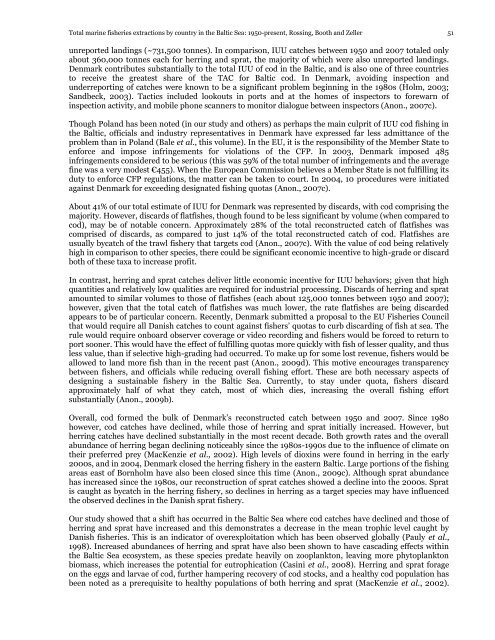Total marine fisheries extractions by country in the Baltic Sea
Total marine fisheries extractions by country in the Baltic Sea
Total marine fisheries extractions by country in the Baltic Sea
Create successful ePaper yourself
Turn your PDF publications into a flip-book with our unique Google optimized e-Paper software.
<strong>Total</strong> <strong>mar<strong>in</strong>e</strong> <strong>fisheries</strong> <strong>extractions</strong> <strong>by</strong> <strong>country</strong> <strong>in</strong> <strong>the</strong> <strong>Baltic</strong> <strong>Sea</strong>: 1950-present, Ross<strong>in</strong>g, Booth and Zeller 51<br />
unreported land<strong>in</strong>gs (~731,500 tonnes). In comparison, IUU catches between 1950 and 2007 totaled only<br />
about 360,000 tonnes each for herr<strong>in</strong>g and sprat, <strong>the</strong> majority of which were also unreported land<strong>in</strong>gs.<br />
Denmark contributes substantially to <strong>the</strong> total IUU of cod <strong>in</strong> <strong>the</strong> <strong>Baltic</strong>, and is also one of three countries<br />
to receive <strong>the</strong> greatest share of <strong>the</strong> TAC for <strong>Baltic</strong> cod. In Denmark, avoid<strong>in</strong>g <strong>in</strong>spection and<br />
underreport<strong>in</strong>g of catches were known to be a significant problem beg<strong>in</strong>n<strong>in</strong>g <strong>in</strong> <strong>the</strong> 1980s (Holm, 2003;<br />
Sandbeck, 2003). Tactics <strong>in</strong>cluded lookouts <strong>in</strong> ports and at <strong>the</strong> homes of <strong>in</strong>spectors to forewarn of<br />
<strong>in</strong>spection activity, and mobile phone scanners to monitor dialogue between <strong>in</strong>spectors (Anon., 2007c).<br />
Though Poland has been noted (<strong>in</strong> our study and o<strong>the</strong>rs) as perhaps <strong>the</strong> ma<strong>in</strong> culprit of IUU cod fish<strong>in</strong>g <strong>in</strong><br />
<strong>the</strong> <strong>Baltic</strong>, officials and <strong>in</strong>dustry representatives <strong>in</strong> Denmark have expressed far less admittance of <strong>the</strong><br />
problem than <strong>in</strong> Poland (Bale et al., this volume). In <strong>the</strong> EU, it is <strong>the</strong> responsibility of <strong>the</strong> Member State to<br />
enforce and impose <strong>in</strong>fr<strong>in</strong>gements for violations of <strong>the</strong> CFP. In 2003, Denmark imposed 485<br />
<strong>in</strong>fr<strong>in</strong>gements considered to be serious (this was 59% of <strong>the</strong> total number of <strong>in</strong>fr<strong>in</strong>gements and <strong>the</strong> average<br />
f<strong>in</strong>e was a very modest €455). When <strong>the</strong> European Commission believes a Member State is not fulfill<strong>in</strong>g its<br />
duty to enforce CFP regulations, <strong>the</strong> matter can be taken to court. In 2004, 10 procedures were <strong>in</strong>itiated<br />
aga<strong>in</strong>st Denmark for exceed<strong>in</strong>g designated fish<strong>in</strong>g quotas (Anon., 2007c).<br />
About 41% of our total estimate of IUU for Denmark was represented <strong>by</strong> discards, with cod compris<strong>in</strong>g <strong>the</strong><br />
majority. However, discards of flatfishes, though found to be less significant <strong>by</strong> volume (when compared to<br />
cod), may be of notable concern. Approximately 28% of <strong>the</strong> total reconstructed catch of flatfishes was<br />
comprised of discards, as compared to just 14% of <strong>the</strong> total reconstructed catch of cod. Flatfishes are<br />
usually <strong>by</strong>catch of <strong>the</strong> trawl fishery that targets cod (Anon., 2007c). With <strong>the</strong> value of cod be<strong>in</strong>g relatively<br />
high <strong>in</strong> comparison to o<strong>the</strong>r species, <strong>the</strong>re could be significant economic <strong>in</strong>centive to high-grade or discard<br />
both of <strong>the</strong>se taxa to <strong>in</strong>crease profit.<br />
In contrast, herr<strong>in</strong>g and sprat catches deliver little economic <strong>in</strong>centive for IUU behaviors; given that high<br />
quantities and relatively low qualities are required for <strong>in</strong>dustrial process<strong>in</strong>g. Discards of herr<strong>in</strong>g and sprat<br />
amounted to similar volumes to those of flatfishes (each about 125,000 tonnes between 1950 and 2007);<br />
however, given that <strong>the</strong> total catch of flatfishes was much lower, <strong>the</strong> rate flatfishes are be<strong>in</strong>g discarded<br />
appears to be of particular concern. Recently, Denmark submitted a proposal to <strong>the</strong> EU Fisheries Council<br />
that would require all Danish catches to count aga<strong>in</strong>st fishers‘ quotas to curb discard<strong>in</strong>g of fish at sea. The<br />
rule would require onboard observer coverage or video record<strong>in</strong>g and fishers would be forced to return to<br />
port sooner. This would have <strong>the</strong> effect of fulfill<strong>in</strong>g quotas more quickly with fish of lesser quality, and thus<br />
less value, than if selective high-grad<strong>in</strong>g had occurred. To make up for some lost revenue, fishers would be<br />
allowed to land more fish than <strong>in</strong> <strong>the</strong> recent past (Anon., 2009d). This motive encourages transparency<br />
between fishers, and officials while reduc<strong>in</strong>g overall fish<strong>in</strong>g effort. These are both necessary aspects of<br />
design<strong>in</strong>g a susta<strong>in</strong>able fishery <strong>in</strong> <strong>the</strong> <strong>Baltic</strong> <strong>Sea</strong>. Currently, to stay under quota, fishers discard<br />
approximately half of what <strong>the</strong>y catch, most of which dies, <strong>in</strong>creas<strong>in</strong>g <strong>the</strong> overall fish<strong>in</strong>g effort<br />
substantially (Anon., 2009b).<br />
Overall, cod formed <strong>the</strong> bulk of Denmark‘s reconstructed catch between 1950 and 2007. S<strong>in</strong>ce 1980<br />
however, cod catches have decl<strong>in</strong>ed, while those of herr<strong>in</strong>g and sprat <strong>in</strong>itially <strong>in</strong>creased. However, but<br />
herr<strong>in</strong>g catches have decl<strong>in</strong>ed substantially <strong>in</strong> <strong>the</strong> most recent decade. Both growth rates and <strong>the</strong> overall<br />
abundance of herr<strong>in</strong>g began decl<strong>in</strong><strong>in</strong>g noticeably s<strong>in</strong>ce <strong>the</strong> 1980s-1990s due to <strong>the</strong> <strong>in</strong>fluence of climate on<br />
<strong>the</strong>ir preferred prey (MacKenzie et al., 2002). High levels of diox<strong>in</strong>s were found <strong>in</strong> herr<strong>in</strong>g <strong>in</strong> <strong>the</strong> early<br />
2000s, and <strong>in</strong> 2004, Denmark closed <strong>the</strong> herr<strong>in</strong>g fishery <strong>in</strong> <strong>the</strong> eastern <strong>Baltic</strong>. Large portions of <strong>the</strong> fish<strong>in</strong>g<br />
areas east of Bornholm have also been closed s<strong>in</strong>ce this time (Anon., 2009c). Although sprat abundance<br />
has <strong>in</strong>creased s<strong>in</strong>ce <strong>the</strong> 1980s, our reconstruction of sprat catches showed a decl<strong>in</strong>e <strong>in</strong>to <strong>the</strong> 2000s. Sprat<br />
is caught as <strong>by</strong>catch <strong>in</strong> <strong>the</strong> herr<strong>in</strong>g fishery, so decl<strong>in</strong>es <strong>in</strong> herr<strong>in</strong>g as a target species may have <strong>in</strong>fluenced<br />
<strong>the</strong> observed decl<strong>in</strong>es <strong>in</strong> <strong>the</strong> Danish sprat fishery.<br />
Our study showed that a shift has occurred <strong>in</strong> <strong>the</strong> <strong>Baltic</strong> <strong>Sea</strong> where cod catches have decl<strong>in</strong>ed and those of<br />
herr<strong>in</strong>g and sprat have <strong>in</strong>creased and this demonstrates a decrease <strong>in</strong> <strong>the</strong> mean trophic level caught <strong>by</strong><br />
Danish <strong>fisheries</strong>. This is an <strong>in</strong>dicator of overexploitation which has been observed globally (Pauly et al.,<br />
1998). Increased abundances of herr<strong>in</strong>g and sprat have also been shown to have cascad<strong>in</strong>g effects with<strong>in</strong><br />
<strong>the</strong> <strong>Baltic</strong> <strong>Sea</strong> ecosystem, as <strong>the</strong>se species predate heavily on zooplankton, leav<strong>in</strong>g more phytoplankton<br />
biomass, which <strong>in</strong>creases <strong>the</strong> potential for eutrophication (Cas<strong>in</strong>i et al., 2008). Herr<strong>in</strong>g and sprat forage<br />
on <strong>the</strong> eggs and larvae of cod, fur<strong>the</strong>r hamper<strong>in</strong>g recovery of cod stocks, and a healthy cod population has<br />
been noted as a prerequisite to healthy populations of both herr<strong>in</strong>g and sprat (MacKenzie et al., 2002).





![Nacion.com, San José, Costa Rica [Nacionales] - Sea Around Us ...](https://img.yumpu.com/26166123/1/190x245/nacioncom-san-josac-costa-rica-nacionales-sea-around-us-.jpg?quality=85)










